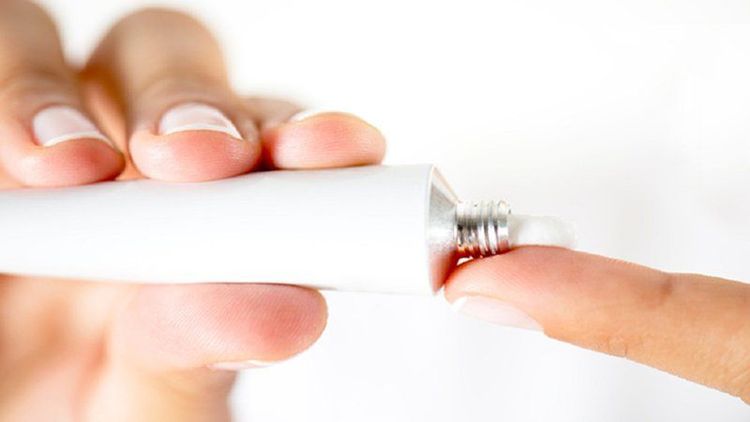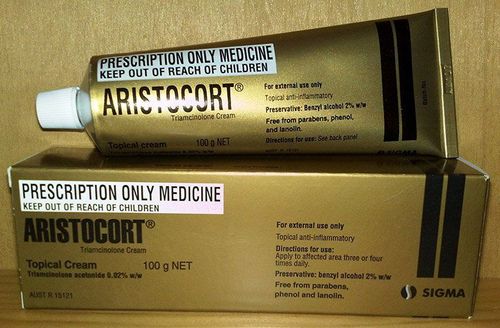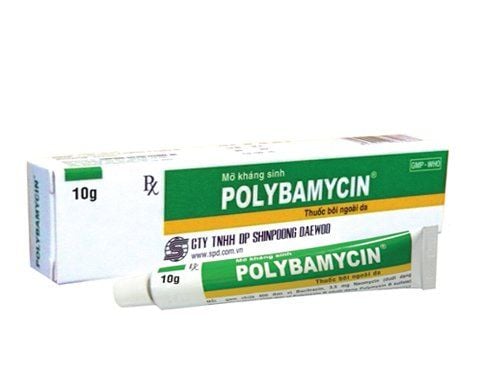This is an automatically translated article.
This article is professionally consulted by Tran Van Sang, a Dermatologist Specialist level I, MD, at the Department of General Examination and Internal Medicine - Vinmec Danang International Hospital.
Folliculitis is a common skin condition that often recurs during the summer due to hot and humid weather. So, what should you do if folliculitis recurs?
1. Causes of Folliculitis
Folliculitis is a prevalent skin condition characterized by small pustules localized in hair follicles. The most common cause is Staphylococcus bacteria, but it can also result from Gram-negative bacteria, yeast, dermatophytes, herpes viruses, and the Demodex parasite. Depending on the causative agent, treatments may involve different topical or oral medications. The primary causes of folliculitis include:
- Hot and humid climate or polluted living environments: These factors directly affect the skin, leading to folliculitis.
- Improper shaving, hair removal, or waxing practices: Using synthetic clothing or tightly wrapping the skin can create favorable conditions for folliculitis.
- Overuse of medications: Prolonged use of topical corticosteroids or antibiotics can encourage anaerobic bacterial growth.
- Underlying health conditions: People with diabetes, weakened immune systems, or hormonal disorders are more prone to folliculitis. Increased sweating, combined with external factors like bacteria or viruses, exacerbates the condition.
Folliculitis is a skin condition that commonly occurs in the summer, especially in hot and humid weather. When sweat production increases and sweat glands become overactive, failure to maintain cleanliness and dryness, particularly in areas like behind the ears, the nape, armpits, or groin, can easily lead to folliculitis in these locations. If you have had folliculitis and it recurs, it is advisable to consult a dermatologist. The doctor will identify the exact cause of the recurrent folliculitis and recommend appropriate medication based on your current condition.

2. Symptoms of folliculitis
Common symptoms of folliculitis include: itching in the inflamed skin area, and the appearance of red bumps, where hairs are trapped inside the follicle and twisted, causing itching in that area. It can involve one or multiple hair follicles, often affecting a wide area of skin. The bumps are small but densely clustered, affecting aesthetics and daily activities. Over time, folliculitis or infected hair follicles can progress to pustules with white pus heads. These pustules are painful to touch and eventually rupture, forming scabs and drying out the skin. In some cases, the condition becomes chronic if it persists for a long time. Patients often experience discomfort due to itching and burning. If not treated promptly, folliculitis can develop into boils, clusters of boils, or deep follicular abscesses. However, with the right medication, this condition is easily treatable and resolves quickly.
Symptoms caused by specific pathogens have the following characteristics:
- Staphylococcal folliculitis: often occurs in the beard area and causes itching. Can leave scars after healing. The disease often recurs in polluted, hot, and humid environments. Some common affecting areas are the armpits, hairline, nape of the neck, and temples,...
- Folliculitis caused by Gram-negative bacteria: typically affects individuals using long-term oral antibiotics for acne. Causes acne to become more severe, causing papules or follicular abscesses on the cheeks and chin.
- Folliculitis caused by filamentous fungi: begins as a fungal infection in the stratum corneum around the opening of the hair follicle, then gradually spreads deeper into the hair follicle. Inflamed hair follicles will cause pustules with interconnected openings between follicles. It can self-resolve but may result in hair loss and scarring.
- Malassezia folliculitis: very common in hot and humid climates. Symptoms are itchy papules and pustules in hair follicles on the back, arms, nape, and face. These lesions are similar to acne but do not have comedones.
- Candida albicans yeast occurs in areas that are exposed to prolonged heat and moisture, such as bedridden patients or areas covered with plastic wraps or corticosteroid creams. Follicular candidiasis causes pustules to form in clusters.
- Viral folliculitis herpes: usually occurs in the beard and mustache areas due to shaving. Appears as follicular vesicles that cluster and scab after a few days. It heals without scarring but tends to recur.
- Sycosis caused by Molluscum contagiosum virus: causing skin-colored papules with a central depression in the hair follicles or around the hair follicles of the beard, chin, and mustache. It is contagious and will typically resolve within a few months, though it can take longer in some cases.
- Syphilitic folliculitis: red papules arranged in an oval shape, causing hair loss but healing without leaving scars.
- Demodex folliculitis: causes flaking of the skin around the hair follicles, resembling follicular pityriasis or seborrheic dermatitis. Can also appear as red papules and pustules around follicles, similar to rosacea on a red facial background.

3. Treatment of recurrent folliculitis
Frequent recurrent folliculitis requires a clear understanding of its causes, identification of bacterial hotspots, assessment for diabetes, and avoidance of skin scratching. Depending on the underlying cause, using appropriate medications can achieve high effectiveness, preventing the condition from worsening and avoiding scarring. Treatment methods include:
- Local treatment: can use anti-microbial topical medications such as betadine, iodine alcohol, antibiotic creams, or ointments such as Bactroban, and fucidin...
- Systemic treatment: in cases of severe inflammation and frequent recurrence, systemic medication can be used.
- Use of antibiotics: in case of recurrent folliculitis caused by staphylococcus, systemic antibiotics can be used when necessary. Systemic antibiotics like β-lactams, amoxicillin, cephalosporins, or metronidazole can be used as needed. Dosage and administration should follow a doctor’s prescription.
- Gram-negative folliculitis: discontinue any ongoing antibiotic therapy, clean the affected area with benzoyl peroxide, and administer ampicillin or co-trimoxazole. In some cases, isotretinoin may be prescribed by a doctor.
- Fungal folliculitis: a combination of topical and oral antifungal drugs will be used. Topical drugs such as Nizoral, Canesten, Mycoster... Oral antifungal drugs such as Itraconazole 100mg, 2 tablets/day for 14 days, or Terbinafine 250mg/day for 14 days. In cases caused by Candida yeast, use Itraconazole 100mg, 2 tablets/day for 14 consecutive days, or Fluconazole 150mg, 2 tablets/day for 14 consecutive days.
- Herpes virus folliculitis: apply Acyclovir cream 6 times/day and take acyclovir orally (400 mg three times daily or 200 mg five times daily) or valacyclovir 500 mg twice daily.
- Folliculitis caused by Demodex: apply permethrin cream or metronidazole cream, combined with oral metronidazole 1 g daily for one week.
The above medications are commonly used for treating recurrent folliculitis. However, the specific medication and dosage must be prescribed by a doctor. Incorrect use of medications can lead to adverse effects or dangerous complications.

4. Preventive measures for recurrent folliculitis
For those frequently affected by recurrent folliculitis, prevention is key. To prevent recurrence, you should Maintain proper hygiene, keeping the skin clean and dry, especially in the summer; bathe with suitable shampoos or soaps; for oily skin, use products that reduce oiliness; reduce intake of starchy and sugary foods, eat plenty of green vegetables, drink more water, and boost B vitamins; seek a dermatologist’s consultation at the first signs of folliculitis.
Additionally, wear breathable clothing that absorbs sweat, avoid contamination, and refrain from scratching or injuring the skin, as this creates an entry point for bacteria, viruses, and fungi to cause folliculitis.
Discontinue moisturizers if you have folliculitis, as they tend to clog pores and worsen the condition. Consult a dermatologist for advice. Doctors may recommend aloe vera or oatmeal-based cosmetics to soothe the skin.
If diagnosed with folliculitis, avoid shaving or hair removal until the inflammation subsides. You can resume these practices but no more than once a month after all blisters or pustules have healed. Sterilize grooming tools, and consider using electric razors. Apply shaving oils or creams to the legs and arms before and after shaving, rinse with warm water, pat dry gently, and use light moisturizers to minimize irritation and acne.
Recurrent folliculitis will no longer be a problem if you understand and manage the condition properly. Hopefully, this article provides useful information to help readers effectively prevent and treat folliculitis.
To arrange an appointment, please call HOTLINE or make your reservation directly HERE. You may also download the MyVinmec app to schedule appointments faster and manage your reservations more conveniently.
To arrange an appointment, please call HOTLINE or make your reservation directly HERE. You may also download the MyVinmec app to schedule appointments faster and manage your reservations more conveniently.









